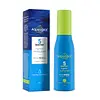What's inside
What's inside
 Key Ingredients
Key Ingredients

 Benefits
Benefits

 Concerns
Concerns

No concerns
 Ingredients Side-by-side
Ingredients Side-by-side

Water
Skin ConditioningCyclopentasiloxane
EmollientPanthenol
Skin ConditioningPEG/PPG-18/18 Dimethicone
EmulsifyingGlycerin
HumectantHydrogenated Polyisobutene
EmollientBetaine
HumectantSodium Hyaluronate
HumectantAllantoin
Skin ConditioningCopper Gluconate
Skin ConditioningDimethicone Crosspolymer
Emulsion StabilisingXylitylglucoside
HumectantAnhydroxylitol
HumectantXylitol
HumectantMagnesium Aspartate
Skin ConditioningZinc Gluconate
Skin ConditioningPentylene Glycol
Skin ConditioningMagnesium Sulfate
Phenoxyethanol
PreservativeHydroxyethyl Acrylate/Sodium Acryloyldimethyl Taurate Copolymer
Emulsion StabilisingCarbomer
Emulsion StabilisingEthylhexylglycerin
Skin ConditioningWater, Cyclopentasiloxane, Panthenol, PEG/PPG-18/18 Dimethicone, Glycerin, Hydrogenated Polyisobutene, Betaine, Sodium Hyaluronate, Allantoin, Copper Gluconate, Dimethicone Crosspolymer, Xylitylglucoside, Anhydroxylitol, Xylitol, Magnesium Aspartate, Zinc Gluconate, Pentylene Glycol, Magnesium Sulfate, Phenoxyethanol, Hydroxyethyl Acrylate/Sodium Acryloyldimethyl Taurate Copolymer, Carbomer, Ethylhexylglycerin
Water
Skin ConditioningCaprylic/Capric Triglyceride
MaskingXylitol
HumectantGlucose
HumectantAnhydroxylitol
HumectantNopalea Cochenillifera Extract
Skin ConditioningSodium Acrylates Copolymer
Lecithin
EmollientPolyglycerin-3
HumectantGenipa Americana Extract
Skin ConditioningDimethicone
EmollientGlyceryl Stearate
EmollientPEG-100 Stearate
Phenoxyethanol
PreservativeEthylhexylglycerin
Skin ConditioningCetearyl Olivate
Sorbitan Olivate
EmulsifyingShea Butter Glycerides
EmulsifyingImidazolidinyl Urea
PreservativeSodium Benzoate
MaskingNiacinamide
SmoothingGlycerin
HumectantErythritol
HumectantHibiscus Esculentus Fruit Extract
Skin ConditioningFucus Vesiculosus Extract
EmollientButylene Glycol
Humectant1,2-Hexanediol
Skin ConditioningGlyceryl Glucoside
HumectantAcrylates/C10-30 Alkyl Acrylate Crosspolymer
Emulsion StabilisingLaminaria Digitata Extract
Skin ProtectingHydrogenated Lecithin
EmulsifyingCetyl-Pg Hydroxyethyl Palmitamide
Skin ConditioningCeramide 1
Skin ConditioningCeramide 2
Skin ConditioningCeramide 3
Skin ConditioningCeramide 4
Skin ConditioningCeramide 6 Ii
Skin ConditioningCholesterol
EmollientHyaluronic Acid
HumectantPanthenol
Skin ConditioningEthoxydiglycol
HumectantTocopheryl Acetate
AntioxidantWater, Caprylic/Capric Triglyceride, Xylitol, Glucose, Anhydroxylitol, Nopalea Cochenillifera Extract, Sodium Acrylates Copolymer, Lecithin, Polyglycerin-3, Genipa Americana Extract, Dimethicone, Glyceryl Stearate, PEG-100 Stearate, Phenoxyethanol, Ethylhexylglycerin, Cetearyl Olivate, Sorbitan Olivate, Shea Butter Glycerides, Imidazolidinyl Urea, Sodium Benzoate, Niacinamide, Glycerin, Erythritol, Hibiscus Esculentus Fruit Extract, Fucus Vesiculosus Extract, Butylene Glycol, 1,2-Hexanediol, Glyceryl Glucoside, Acrylates/C10-30 Alkyl Acrylate Crosspolymer, Laminaria Digitata Extract, Hydrogenated Lecithin, Cetyl-Pg Hydroxyethyl Palmitamide, Ceramide 1, Ceramide 2, Ceramide 3, Ceramide 4, Ceramide 6 Ii, Cholesterol, Hyaluronic Acid, Panthenol, Ethoxydiglycol, Tocopheryl Acetate
 Reviews
Reviews

Ingredients Explained
These ingredients are found in both products.
Ingredients higher up in an ingredient list are typically present in a larger amount.
This ingredient is created from dehydrating xylitol in acidic conditions. Xylitol is a famous sugar and humectant.
Much like its predecessor, anhydroxylitol is a humectant. Humectants attract and hold water to moisturize the skin.
This ingredient is most commonly found in a popular trio called Aquaxyl. Aquaxyl is made up of anhydroxylitol (24 - 34%), xylitylglucoside (35 - 50%), and xylitol (5 - 15%).
According to a manufacturer, Aquaxyl is known for a 3-D hydration concept and an anti-dehydration shield to reinforce the outer layer of skin.
This ingredient is often derived from plants such as wood and sugarcane.
Learn more about AnhydroxylitolEthylhexylglycerin (we can't pronounce this either) is commonly used as a preservative and skin softener. It is derived from glyceryl.
You might see Ethylhexylglycerin often paired with other preservatives such as phenoxyethanol. Ethylhexylglycerin has been found to increase the effectiveness of these other preservatives.
Glycerin is already naturally found in your skin. It helps moisturize and protect your skin.
A study from 2016 found glycerin to be more effective as a humectant than AHAs and hyaluronic acid.
As a humectant, it helps the skin stay hydrated by pulling moisture to your skin. The low molecular weight of glycerin allows it to pull moisture into the deeper layers of your skin.
Hydrated skin improves your skin barrier; Your skin barrier helps protect against irritants and bacteria.
Glycerin has also been found to have antimicrobial and antiviral properties. Due to these properties, glycerin is often used in wound and burn treatments.
In cosmetics, glycerin is usually derived from plants such as soybean or palm. However, it can also be sourced from animals, such as tallow or animal fat.
This ingredient is organic, colorless, odorless, and non-toxic.
Glycerin is the name for this ingredient in American English. British English uses Glycerol/Glycerine.
Learn more about GlycerinPanthenol is a common ingredient that helps hydrate and soothe the skin. It is found naturally in our skin and hair.
There are two forms of panthenol: D and L.
D-panthenol is also known as dexpanthenol. Most cosmetics use dexpanthenol or a mixture of D and L-panthenol.
Panthenol is famous due to its ability to go deeper into the skin's layers. Using this ingredient has numerous pros (and no cons):
Like hyaluronic acid, panthenol is a humectant. Humectants are able to bind and hold large amounts of water to keep skin hydrated.
This ingredient works well for wound healing. It works by increasing tissue in the wound and helps close open wounds.
Once oxidized, panthenol converts to pantothenic acid. Panthothenic acid is found in all living cells.
This ingredient is also referred to as pro-vitamin B5.
Learn more about PanthenolPhenoxyethanol is a preservative that has germicide, antimicrobial, and aromatic properties. Studies show that phenoxyethanol can prevent microbial growth. By itself, it has a scent that is similar to that of a rose.
It's often used in formulations along with Caprylyl Glycol to preserve the shelf life of products.
Water. It's the most common cosmetic ingredient of all. You'll usually see it at the top of ingredient lists, meaning that it makes up the largest part of the product.
So why is it so popular? Water most often acts as a solvent - this means that it helps dissolve other ingredients into the formulation.
You'll also recognize water as that liquid we all need to stay alive. If you see this, drink a glass of water. Stay hydrated!
Learn more about WaterXylitol is a humectant and prebiotic. It can help with dry skin.
In studies, xylitol has been shown to improve dry skin. It decreased transepidermal water loss, or when water passes through the skin and evaporates. Xylitol also showed to help improve the biomechanical properties of the skin barrier.
The prebiotic property of xylitol may also help reinforce our skin's natural microbiome. Having a healthy microbiome prevents infection by bad bacteria and helps with hydration.
As a humectant, Xylitol helps draw moisture from both the air and from deeper skin layers. This helps keep skin hydrated.
Xylitol is a sugar alcohol and commonly used as a sugar substitute. It is naturally occurring in plants such as strawberries and pumpkin.
Learn more about Xylitol